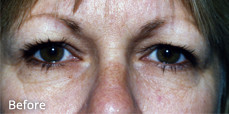Why Consider Eyelid Surgery?
When interacting with others, the eyes and eyelids are probably the most important features on our face. They show a tremendous amount of emotion. It is natural for us to gaze into each other’s eyes to determine happiness, sadness, anger, vigor or fatigue. Any visit to a store selling cosmetics attests to the emphasis on the attractiveness of the eyelids. In order for these cosmetics to be really effective, they have to be applied to well-shaped, smooth eyelids. Taking away the excess skin and puffiness that occurs with aging is the purpose of eyelid surgery. The result is that patients look well-rested and friendlier.
Who is a Candidate for Eyelid Surgery?
Most of us would benefit from eyelid surgery in our 40’s or 50’s. Individuals with allergies, those who don’t get enough sleep, those with thin or dry skin, and individuals born with weakness of components of the eyelids may show more severe aging at earlier ages. Eyelid surgery is popular with men and women. Results of the surgery are helpful in presenting an energetic, attentive appearance in work and social situations.
What is Done During Eyelid Surgery?
Upper and lower eyelid surgery usually takes about one hour. It is performed in an outpatient surgery center. Currently, I use the Aspen Surgery Center associated with John Muir Hospital in Walnut Creek. The surgery is usually done under general anesthesia. This assures a painless operation and a rapid recovery from the anesthesia. Some patients prefer “twilight anesthesia” with sedatives and local anesthesia. This is certainly an option for the proper patient.
Upper eyelid surgery almost always involves removal of excess skin. This leaves a scar along the upper eyelid crease that extends into the crows’ feet area. Lower eyelid surgery may or may not involve removal of skin. If there is no excess skin, the scars are in the inner eyelid (the side that rests on the eye). There are no sutures and no visible scars. If excess skin is removed, the scars are just below the eyelashes and extend into the crows’ feet. They are in a natural crease, and are very difficult to detect.
What is the Healing Process Like?
Sutures are removed at five days after surgery. The upper eyelids are bruised for about 7-10 days. The lower eyelids are bruised for about three weeks. The scars are difficult to detect after about three months. Most patients are able to return to work after 1-2 weeks. There is mild to moderate pain during the first week.
What are the Most Common Complications?
It is important not to remove too much skin from the upper or lower eyelids. This may result in the eyelids not closing together easily, which can lead to eye dryness, irritation and sun sensitivity. An unsettling stare can result. Too much skin may be left, and too little skin or too much fat may be removed. I have a lot of experience with eyelid surgery, which helps in judging the best amount of skin and fat removal.
Watch Dr. Lavey’s Video – Eyelid Surgery To Improve the Face’s Overall Presentation
CLICK HERE to view our before & after gallery for eyelid surgery (blepharoplasty)









